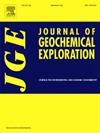印度查谟和克什米尔多达地区一些野生食用植物中潜在有毒元素的评估
IF 3.4
2区 地球科学
Q1 GEOCHEMISTRY & GEOPHYSICS
引用次数: 0
摘要
自古以来,野生食用植物在维持全球各地当地社区的生计方面发挥着至关重要的作用,尤其是在食物匮乏的情况下,可以补充家庭饮食。尽管野生食用植物具有重要意义,但人们对其营养成分的研究一直不足,普遍了解甚少。此外,对营养成分的研究通常会忽略可能对人体健康有害的潜在有毒元素(PTEs)的存在。本研究旨在评估多达地区农村居民传统食用的部分野生植物中的潜在有毒元素(铝、砷、钡、镉、钴、铬、铜、铁、汞、锰、镍、铅、硒、锶和锌)含量。为此,研究人员采集了三种野生食用植物的叶子,即 Taraxacum officinale、Urtica dioica 和 Phytolacca acinosa,将其风干并加工成粉末。使用电感耦合等离子体质谱仪(ICP-MS)对植物样本进行了分析。研究结果表明,在所有三种受测野生食用植物中都能检测到 PTEs。PTEs 的含量(毫克/1000 克重)分别为铜(18.1 至 36.1)、铁(646.6 至 1457.8)、锰(80.4 至 207.6)、硒(0.1 至 0.3)和锌(58.2 至 86.8),在所有三种分析过的植物样本中还检测到了 PTEs Al、As、Ba、Cd、Co、Cr、Hg、Ni、Pb 和 Sr。在这些 PTE 中,铝的含量最高(427.7 至 1224.4 毫克/1000 克干重),会对健康造成危害。本文章由计算机程序翻译,如有差异,请以英文原文为准。
Assessment of potentially toxic elements in some wild edible plants of district Doda, Jammu and Kashmir, India
Wild edible plants have played a crucial role since ages, in sustaining the local communities across globe, particularly during food scarcity, by supplementing the household diets. Despite their significance, the nutritional composition of wild edible plants has been inadequately researched and generally poorly understood. Moreover the studies of nutritional contents usually overlook the presence of potentially toxic elements(PTEs) which may be detrimental to the human health. This study was aimed at assessing the levels of PTEs (Al, As, Ba, Cd, Co, Cr, Cu, Fe, Hg, Mn, Ni, Pb, Se, Sr and Zn), in selected wild edible plants traditionally consumed by rural people of District Doda. For this purpose the leaves of three wild edible plants, namely Taraxacum officinale, Urtica dioica and Phytolacca acinosa were collected, air-dried and processed into powder. The plant samples were analyzed using Inductively Coupled Plasma Mass Spectrometer (ICP-MS). The findings of this study exhibited that PTEs were detectable in all the three tested wild edible plants. The levels of PTEs (mg/1000gdw) were found to be Cu (18.1 to 36.1), Fe (646.6 to 1457.8), Mn (80.4 to 207.6), Se (0.1 to 0.3) and Zn (58.2 to 86.8), PTEs Al, As, Ba, Cd, Co, Cr, Hg, Ni, Pb, and Sr were also detectable in all the three analyzed plant samples. The Al content was found to be highest among these PTEs (427.7 to 1224.4 mg/ 1000 g dw) which can pose health risks.
求助全文
通过发布文献求助,成功后即可免费获取论文全文。
去求助
来源期刊

Journal of Geochemical Exploration
地学-地球化学与地球物理
CiteScore
7.40
自引率
7.70%
发文量
148
审稿时长
8.1 months
期刊介绍:
Journal of Geochemical Exploration is mostly dedicated to publication of original studies in exploration and environmental geochemistry and related topics.
Contributions considered of prevalent interest for the journal include researches based on the application of innovative methods to:
define the genesis and the evolution of mineral deposits including transfer of elements in large-scale mineralized areas.
analyze complex systems at the boundaries between bio-geochemistry, metal transport and mineral accumulation.
evaluate effects of historical mining activities on the surface environment.
trace pollutant sources and define their fate and transport models in the near-surface and surface environments involving solid, fluid and aerial matrices.
assess and quantify natural and technogenic radioactivity in the environment.
determine geochemical anomalies and set baseline reference values using compositional data analysis, multivariate statistics and geo-spatial analysis.
assess the impacts of anthropogenic contamination on ecosystems and human health at local and regional scale to prioritize and classify risks through deterministic and stochastic approaches.
Papers dedicated to the presentation of newly developed methods in analytical geochemistry to be applied in the field or in laboratory are also within the topics of interest for the journal.
 求助内容:
求助内容: 应助结果提醒方式:
应助结果提醒方式:


